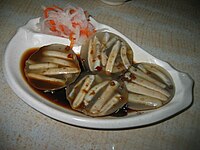
Cantonese or Guangdong cuisine, also known as Yue cuisine, is the cuisine of Guangdong province of China, particularly the provincial capital Guangzhou, and the surrounding regions in the Pearl River Delta including Hong Kong and Macau. Strictly speaking, Cantonese cuisine is the cuisine of Guangzhou or of Cantonese speakers, but it often includes the cooking styles of all the speakers of Yue Chinese languages in Guangdong.

Teochew cuisine, also known as Chiuchow cuisine, Chaozhou cuisine or Teo-swa cuisine, originated from the Chaoshan region in the eastern part of China's Guangdong Province, which includes the cities of Chaozhou, Shantou and Jieyang. Teochew cuisine bears more similarities to that of Fujian cuisine, particularly Southern Min cuisine, due to the similarity of Teochew's and Fujian's culture, language, and their geographic proximity to each other. However, Teochew cuisine is also influenced by Cantonese cuisine in its style and technique.

Malaysian cuisine consists of cooking traditions and practices found in Malaysia, and reflects the multi-ethnic makeup of its population. The vast majority of Malaysia's population can roughly be divided among three major ethnic groups: Malays, Chinese and Indians. The remainder consists of the indigenous peoples of Sabah and Sarawak in East Malaysia, the Orang Asli of Peninsular Malaysia, the Peranakan and Eurasian creole communities, as well as a significant number of foreign workers and expatriates.

Indonesian cuisine is a collection of various regional culinary traditions that formed in the archipelagic nation of Indonesia. There are a wide variety of recipes and cuisines in part because Indonesia is composed of approximately 6,000 populated islands of the total 17,508 in the world's largest archipelago, with more than 1,300 ethnic groups.
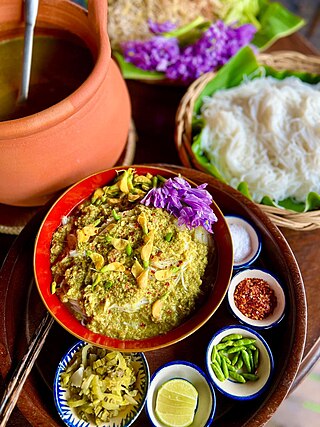
Cambodian cuisine combines the culinary traditions of many different ethnic groups in Cambodia, an important subset of which is Khmer cuisine, the nearly-two-thousand-year-old culinary tradition of the majority Khmer people. Over centuries, Cambodian cuisine has incorporated elements of Indian, Chinese, Portuguese and French cuisine, and due to some of these shared influences and mutual interaction, it has many similarities with the cuisines of Central Thailand, and Southern Vietnam and to a lesser extent also Central Vietnam, Northeastern Thailand and Laos.

Hokkien mee, literally "Fujian noodles", is a series of related Southeast Asian dishes that have their origins in the cuisine of China's Fujian (Hokkien) province.

Singaporean cuisine is derived from several ethnic groups in Singapore and has developed through centuries of political, economic, and social changes in the cosmopolitan city-state.

Fish balls are the balls made from fish paste which are then boiled or deep-fried. Similar in composition to fishcake, fish balls are often made from fish mince or surimi, salt, and a culinary binder such as tapioca flour, corn, or potato starch.

Chinese Indonesian cuisine is characterized by the mixture of Chinese with local Indonesian style. Chinese Indonesians, mostly descendant of Han ethnic Hokkien and Hakka speakers, brought their legacy of Chinese cuisine, and modified some of the dishes with the addition of Indonesian ingredients, such as kecap manis, palm sugar, peanut sauce, chili, santan and local spices to form a hybrid Chinese-Indonesian cuisine. Some of the dishes and cakes share the same style as in Malaysia and Singapore, known as Nyonya cuisine by the Peranakan.

Filipino Chinese cuisine is a style of Filipino cuisine influenced from Chinese cuisine, historically brought to the Philippines by Chinese Filipinos, starting with the Sangley Chinese and their Chinese mestizo descendants and modern descendants in the Chinese Filipino community of the Philippines. It is characterized as a fusion of Fujian/Hokkien cuisine and Cantonese cuisine adapted over the centuries to Filipino cuisine to suit the general Filipino palate/taste.

Korean Chinese cuisine, also known as Sino–Korean cuisine, is a hybrid cuisine developed by the ethnic Chinese in Korea.
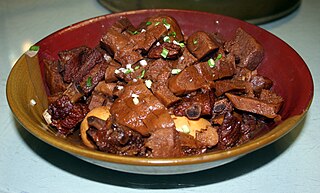
Shandong cuisine, more commonly known in Chinese as Lu cuisine, is one of the Eight Culinary Traditions of Chinese cuisine and one of the Four Great Traditions. It is derived from the native cooking style of Shandong Province, a northern coastal province of China.
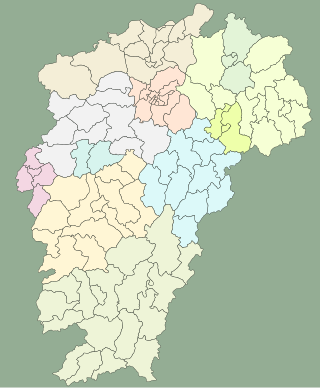
Jiangxi cuisine, also known as Gan cuisine, is a style of Chinese cuisine derived from the native cooking styles of Jiangxi province in southern China. According to the East China Travel Guide published in 1983, Jiangxi Cuisine has its unique taste which can be described in four Chinese idioms: 原汁原味(aim to bring out the own flavor of the cooking material),油厚不腻(dishes contained a significant amount of oil but the taste are not greasy),口味浓厚(dishes have really thick taste),咸鲜兼辣(always come with spicy solid, salty flavor). Jiangxi cuisine is widely popular within the ordinary family because most of the notable dishes from Jiangxi cuisine are the extension of homely dishes with solid local flavor.

Bumbu is the Indonesian word for a blend of spices and for pastes and it commonly appears in the names of spice mixtures, sauces and seasoning pastes. The official Indonesian language dictionary describes bumbu as "various types of herbs and plants that have a pleasant aroma and flavour — such as ginger, turmeric, galangal, nutmeg and pepper — used to enhance the flavour of the food."

Chinese regional cuisines are amongst the many different cuisines found in different provinces and prefectures of China as well as from larger overseas Chinese communities.

Sarawakian cuisine is a regional cuisine of Malaysia. Like the rest of Malaysian cuisine, Sarawak food is based on staples such as rice. There is also a great variety of other ingredients and food preparations due to the influence of the state's varied geography and indigenous cultures quite distinct from the regional cuisines of the Peninsular Malaysia. Sarawak is famous for its multi-ethnic population. As the homeland of many unique communities, Sarawak has a variety of cuisines rarely found elsewhere in Malaysia. The uniqueness of Sarawak well depends on its ethnic groups. Every native group in Sarawak has their own lifestyle, traditions, cultures and also foods. Sarawak cuisine is less spicy and has a subtle in taste. It uses fresh seafood and natural herbs like turmeric, lemongrass, ginger, lime and tapioca leaves. These ingredients are not only easily available, but also add a hint of aroma, texture and freshness to the delicacies. Food is one of the most cultural identities for native groups in Sarawak with each ethnic group having their own delicacies. Among the Iban, popular foods include tubu (stems), tuak and pansuh. The Malay have bubur pedas (porridge) and kek lapis Sarawak ; the Bidayuh have asam siok and sup ponas Bidayuh. The Melanau make tebaloi, sagu and umai and the Orang Ulu are known for garam barrio, kikid (broth), tengayen, and urum giruq (pudding).
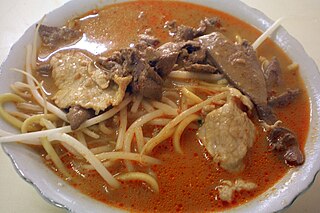
Shacha noodles, also known as sate or satay noodles, is a noodle dish popular in southern Fujian province. It is a kind of soup noodles made by cooking satay soup made from satay sauce and adding bean sprouts, pork liver, and other ingredients.


